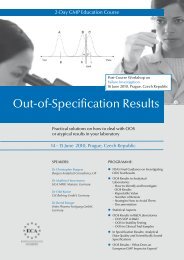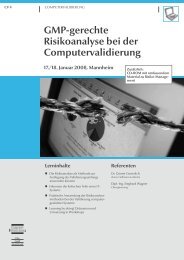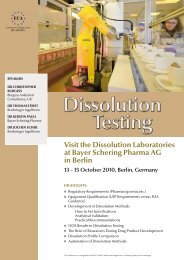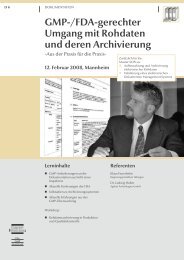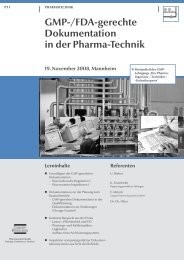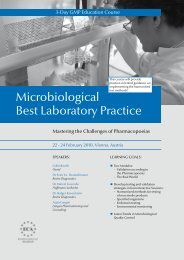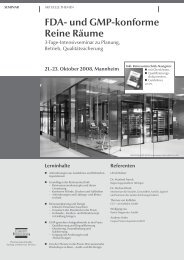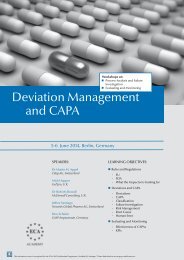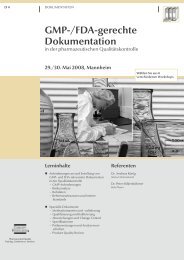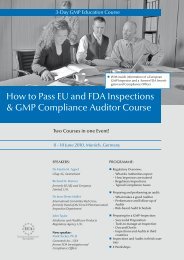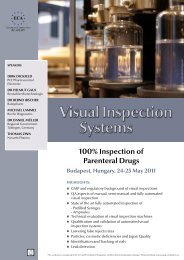Quality by Design in Pharmaceutical Analysis
Quality by Design in Pharmaceutical Analysis
Quality by Design in Pharmaceutical Analysis
You also want an ePaper? Increase the reach of your titles
YUMPU automatically turns print PDFs into web optimized ePapers that Google loves.
<strong>Quality</strong> <strong>by</strong> <strong>Design</strong> <strong>in</strong> <strong>Pharmaceutical</strong> <strong>Analysis</strong><br />
7 – 8 December 2011, Frankfurt, Germany<br />
Objectives<br />
The aim of this two day course is to provide guidance on<br />
how QbD pr<strong>in</strong>ciples can be applied to analytical methods<br />
and identify the opportunities, not only for new development<br />
products, but also for drugs already marketed.<br />
This course will deal among others with the follow<strong>in</strong>g<br />
questions:<br />
• What are the opportunities of apply<strong>in</strong>g QbD to<br />
analytical methods<br />
• What is the purpose of the PhRMA/EFPIA Position<br />
Paper on analytical QbD<br />
• How can the Analytical Target Profile <strong>in</strong>crease regulatory<br />
flexibility<br />
• Why is it important to have a clear understand<strong>in</strong>g and<br />
expectation of method performance<br />
• What is the impact of QbD on method development,<br />
validation and transfer<br />
• How can QbD also benefit marketed products<br />
A number of <strong>in</strong>teractive workshops will be provided<br />
throughout the two days which will enable delegates to<br />
be able to apply what they have learnt and to discuss the<br />
concepts <strong>in</strong> more detail. Delegates will have the opportunity<br />
to work through the whole QbD process <strong>by</strong> ga<strong>in</strong><strong>in</strong>g<br />
“hands-on experience” us<strong>in</strong>g a number of case studies.<br />
Background:<br />
The pharmaceutical <strong>in</strong>dustry is currently embrac<strong>in</strong>g QbD<br />
concepts to help improve the robustness of manufactur<strong>in</strong>g<br />
processes and to facilitate cont<strong>in</strong>uous improvement<br />
strategies to enhance product quality and manufactur<strong>in</strong>g<br />
productivity. QbD ensures product and process performance<br />
characteristics are scientifically designed to meet<br />
specific objectives, not merely empirically derived from<br />
the performance of test batches. Key QbD concepts are<br />
described <strong>in</strong> ICH guidel<strong>in</strong>es Q8 (R1) <strong>Pharmaceutical</strong> Development,<br />
Q9 <strong>Quality</strong> Risk management and Q10 <strong>Pharmaceutical</strong><br />
<strong>Quality</strong> System. The same opportunities exist<br />
for apply<strong>in</strong>g QbD to analytical methods as they do for<br />
manufactur<strong>in</strong>g processes.<br />
Dur<strong>in</strong>g the course an overview of a position paper written<br />
jo<strong>in</strong>tly <strong>by</strong> PhRMA and EFPIA will be provided which<br />
uses a new concept called the Analytical Target Profile<br />
(ATP). The ATP is a statement that def<strong>in</strong>es the method’s<br />
purpose which is used to drive method selection, design<br />
and development activities. It is hoped that greater cont<strong>in</strong>uous<br />
improvement of methods can also be facilitated<br />
if regulatory authorities agree with and approve the ATP<br />
statement. Each method conform<strong>in</strong>g to the ATP requirements<br />
would be implemented <strong>by</strong> the company’s <strong>in</strong>ternal<br />
change control management system, thus provid<strong>in</strong>g regulatory<br />
flexibility. Risk assessment tools and statistical<br />
methods used to facilitate understand<strong>in</strong>g of the method<br />
performance characteristics (e.g. accuracy and precision)<br />
and their acceptance criteria will also be covered. Traditional<br />
method validation will be compared to a QbD approach<br />
which <strong>in</strong>cludes life-cycle aspects <strong>in</strong>stead of a one<br />
off validation exercise.<br />
Note: In order to fully benefit from the workshops,<br />
attendees should preferably br<strong>in</strong>g a notebook with<br />
Excel®.<br />
Target Group<br />
This course is designed for analytical managers and scientists<br />
who are responsible for perform<strong>in</strong>g or review<strong>in</strong>g<br />
activities like method development, validation, transfer,<br />
operation of methods <strong>in</strong> a QC environment, statistical<br />
evaluation of method performance, analytical change<br />
control etc.<br />
In addition, QA and regulatory affairs professionals will<br />
benefit from this course <strong>by</strong> ga<strong>in</strong><strong>in</strong>g an understand<strong>in</strong>g <strong>in</strong><br />
future CMC trends. This will aid more effective multifunctional<br />
discussions on these topics with<strong>in</strong> <strong>in</strong>dustry.<br />
Programme<br />
Introduction to Analytical QbD<br />
• Overview on proposals of EFPIA/PhRMA Paper<br />
• Analytical Target Profile<br />
• Application of QbD pr<strong>in</strong>ciples to pharmaceutical<br />
analysis<br />
• Change Control and regulatory flexibility<br />
<strong>Design</strong> Intent of the Method – ATP and Bus<strong>in</strong>ess Requirements<br />
• L<strong>in</strong>kage with process control strategy (critical quality<br />
attributes)<br />
• Def<strong>in</strong>ition of ATP<br />
• Method Performance Characteristics and their criteria<br />
• Bus<strong>in</strong>ess requirements of method<br />
Understand<strong>in</strong>g the ATP – Analytical Variability<br />
• Sources of analytical variability<br />
• Method performance characteristics: accuracy and<br />
precision<br />
• Method performance and expectation ranges for<br />
experimental results and statistical parameters<br />
• Decision rules and establishment of acceptance limits<br />
Workshop on Variability<br />
• Application of statistical simulations<br />
• Ga<strong>in</strong> experience (“feel<strong>in</strong>g”) for the consequences of<br />
variability<br />
• Method performance statistical measures for<br />
precision, accuracy, l<strong>in</strong>earity<br />
• Probability of OOS and out-of acceptance criteria<br />
situations




